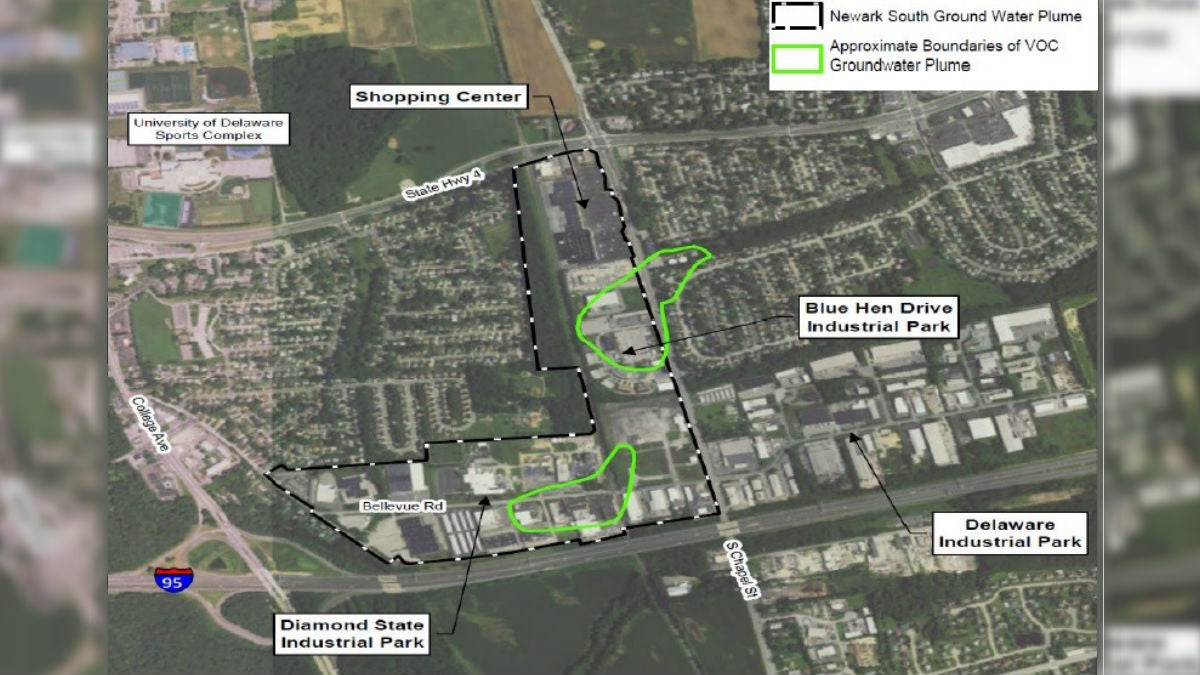Newark groundwater site considered for National Priorities List

This DNREC map shows the location of the Newark South Ground Water Plume outlined in black. (DNREC photo)
A groundwater plume site in Newark beset by contamination could receive national funding for analysis and cleanup efforts.
The U.S. Environmental Protection Agency is proposing to add the Newark South Groundwater Plume site to the National Priorities List of Superfund sites, which would make it eligible for federally financed remedial action.
“My goal as administrator is to restore the Superfund program to its rightful place at the center of the agency’s core mission. Today, we are adding and proposing sites to the Superfund National Priorities List to ensure they are cleaned up for the benefit of these communities,” said EPA Administrator Scott Pruitt in a statement. “When we clean up these sites, we make communities healthier places to live, and clear the way for development and increased economic activity.”
In November, the state’s Department of Natural Resources and Environmental Control asked the EPA for funds to tackle the volatile organic compounds that had contaminated the groundwater for several years.
Newark has six municipal wells located in the area where ground water has been impacted by VOCs.
VOCs are found in some industrial and commercial products, and can cause adverse human health effects if not addressed.
In order to address the issue, a treatment system was installed in 2002 to treat the ground water and ensure drinking water met federal and state criteria. DNREC and EPA said the water meets those standards, and Newark residents are not adversely affected by the contamination.
However, numerous investigations conducted by DNREC to determine the source or sources of the contamination and its extent have been unsuccessful.
Placing the site on the NPL would ensure it would receive federal funding to investigate the issue and find the source or sources of the contamination. Once achieved, federal funds can mitigate or clean up the source.
VOCs are common contaminants found in superfund sites, but the type of treatment needed, the extent of the cleanup and the cost for the Newark site are still to be determined, said Charlie Root, Chief of the Delaware, Virginia, West Virginia Remedial Branch in Epa Region 3.
Following a public comment process, the site could be listed in about six months.
“In this instance, we want to make sure the groundwater is cleaned up to its more beneficial use, which would be the public drinking water,” Root said.
“There are public drinking water supplies and wells in that area that have always been treated before supply to the public, but obviously we would like to be able to have that water be able not to have to be treated, and determine the source of the contamination so it can be cleaned up, so there wouldn’t necessarily need to be treatment of the water.”
The listing comes at a time when Delaware’s Hazardous Substance Cleanup Act fund has been reduced significantly, limiting DNREC investigations, according to the department.
“We are pleased that EPA’s proposed National Priorities Listing for the Newark South Ground Water Plume site enables us to further our efforts to better understand the extent of ground water contamination in the Newark area,” said DNREC Secretary Shawn Garvin in a statement. “We continue partnering with EPA to address historical contamination in the area as we work to protect and restore Delaware’s precious ground water resources.”
EPA will receive public comment on the proposed listing for the next 60 days. The agency has scheduled a public meeting to explain details of the site on Tuesday, August 15 from 6:30-8:30 p.m. at the Newark Senior Center at 200 White Chapel Drive in Newark.
WHYY is your source for fact-based, in-depth journalism and information. As a nonprofit organization, we rely on financial support from readers like you. Please give today.


